Extracting unique values from a comma-separated list in Google Sheets is quite simple. These lists can contain email addresses, names, product IDs, item codes, or similar data.
To achieve this, we can use a combination of SPLIT, TOCOL, UNIQUE, and SORT functions. However, by default, uniqueness is case-sensitive. If you want to ignore case, you need to use PROPER, UPPER, or LOWER functions along with these formulas.
If you prefer to keep the original text format intact while ignoring case, an alternative formula is required. We’ll cover all these approaches in this guide.
Case-Sensitive Formula
=SORT(UNIQUE(TOCOL(SPLIT(A2:A, ", ", FALSE), 3)))- Replace
A2:Awith the actual reference containing your comma-separated list. - If your list is separated by just a comma (
,), instead of a comma followed by a space (", "), adjust the delimiter accordingly.
This method is useful for removing duplicates in inventory systems where case sensitivity matters, such as differentiating between ab123 and AB123, product IDs, passwords, and more.
Case-Insensitive Formulas
Option 1: Changing Case Before Extraction
=SORT(UNIQUE(PROPER(TOCOL(SPLIT(A2:A, ", ", FALSE), 3))))- This formula extracts unique items while formatting the output to proper case.
- If needed, replace
PROPERwithLOWERorUPPERto format the results accordingly.
Option 2: Keeping the Original Case
If you don’t want to modify the case but still want case-insensitive uniqueness, use:
=LET(list, A2:A, uniqueL, SORT(TOCOL(SPLIT(list, ", ", FALSE), 3)), FILTER(uniqueL, COUNTIFS(uniqueL, uniqueL, SEQUENCE(ROWS(uniqueL)), "<="&SEQUENCE(ROWS(uniqueL))) = 1))If “Apple” and “apple” both appear, this method retains the first occurrence while ignoring case differences.
Extracting Unique Values from a Comma-Separated List – Case-Sensitive
Assume you have item codes stored in A2:A. To extract unique values while preserving case differences, use:
=SORT(UNIQUE(TOCOL(SPLIT(A2:A, ", ", FALSE), 3)))
How It Works:
- SPLIT separates the comma-separated values into individual cells.
- TOCOL arranges them into a single column.
- UNIQUE removes duplicates while maintaining case sensitivity.
- SORT orders the values alphabetically and ensures SPLIT works correctly in an array formula.
Extracting Unique Values from a Comma-Separated List – Case-Insensitive
If you want to ignore case differences while extracting unique values, follow these methods.
Solution 1: Changing Case
=SORT(UNIQUE(PROPER(TOCOL(SPLIT(A2:A, ", ", FALSE), 3))))- This method ensures that similar values like
appleandAppleare treated as the same and formatted accordingly. - Replace
PROPERwithLOWERorUPPERif you prefer a different text format.

Solution 2: Without Changing Case
If you want case insensitivity but prefer to retain the original text format, use:
=LET(list, A2:A, uniqueL, SORT(TOCOL(SPLIT(list, ", ", FALSE), 3)), FILTER(uniqueL, COUNTIFS(uniqueL, uniqueL, SEQUENCE(ROWS(uniqueL)), "<="&SEQUENCE(ROWS(uniqueL))) = 1))This method ensures that the first occurrence of a value is kept in its original case while removing duplicates case-insensitively.

Explanation:
SORT(TOCOL(SPLIT(list, ", ", FALSE), 3))– Splits the list, arranges items into a column, and sorts them.FILTER(uniqueL, COUNTIFS(uniqueL, uniqueL, SEQUENCE(ROWS(uniqueL)), "<="&SEQUENCE(ROWS(uniqueL))) = 1)– Filters unique values without altering their original format.
Conclusion
We explored three different ways to extract unique values from a comma-separated list in Google Sheets:
- Case-Sensitive Extraction – Useful for passwords, item codes, or any data where case matters.
- Case-Insensitive Extraction (Changing Case) – Suitable for names, product names, or other text where formatting is acceptable.
- Case-Insensitive Extraction (Preserving Case) – Ideal when you want unique values while maintaining their original format.
For more advanced methods, you can check out these related guides:




















Can this be done in the Excel online workbooks?
Hi, S,
We can do it. But remember, at present, SPLIT() is not available in Excel.
There is a workaround formula.
For formula explanation, please check this guide. In that, you can find a step#4 formula.
Wrap that formula output with UNIQUE, then SORT.
Hi Prashanth.
Please help how to have an ArrayFormula only in B2 (so B3 and B4 will get the value from the formula in B2).
List of Items
A2: Box File, Flat File, Time Cards, Box File
A3: Glue, Time Cards, Glue, Glue
A4: Pencil, Pen, Glue, Pen
Extracted Unique List (Expected result)
B2: Box File, Flat File, Time Cards
B3: Glue, Time Cards
B4: Pencil, Pen, Glue
Thank you in advance.
Hi, Zaim,
I suggest a drag-drop formula in B2.
=ArrayFormula(textjoin(", ",true,unique(trim(split(A2,",")),true)))Since you want an array formula, try the below one.
=ArrayFormula(TRIM(transpose(split(textjoin(", ",true,if(row(indirect("A2:A"&counta(left(filter(iferror(unique(flatten(
TRIM(split(substitute(if(len(A2:A99),row(A2:A99)&" "&A2:A99,),",",
", "&row(A2:A99)),","))))),iferror(unique(flatten(TRIM(split(
substitute(if(len(A2:A99),row(A2:A99)&" "&A2:A99,),",",", "&
row(A2:A99)),",")))))<>""),1))+1))-match(left(filter(iferror(
unique(flatten(TRIM(split(substitute(if(len(A2:A99),row(A2:A99)&
" "&A2:A99,),",",", "&row(A2:A99)),","))))),iferror(unique(
flatten(TRIM(split(substitute(if(len(A2:A99),row(A2:A99)&" "&A2:A99,),
",",", "&row(A2:A99)),",")))))<>""),2),left(filter(iferror(unique(
flatten(TRIM(split(substitute(if(len(A2:A99),row(A2:A99)&" "&A2:A99,),",",", "&row(A2:A99)),","))))),iferror(unique(flatten(TRIM(split(substitute(if(
len(A2:A99),row(A2:A99)&" "&A2:A99,),",",", "&row(A2:A99)),",")))))<>""),2),0)=1,"|",)&ArrayFormula(mid(filter(iferror(unique(flatten(TRIM(
split(substitute(if(len(A2:A99),row(A2:A99)&" "&A2:A99,),",",", "&
row(A2:A99)),","))))),iferror(unique(flatten(TRIM(split(substitute(if(
len(A2:A99),row(A2:A99)&" "&A2:A99,),",",", "&row(A2:A99)),",")))))<>""),
3,150))),"|"))))
Note:
1. Set to work from row 2 to 99.
2. After each comma separating the words, there should be a white space as shown in your example.
Wow, the ArrayFormula, the length… But amazing solution.
Let me test it in my real data first.
Thanks again. You’re great.
Hi, Zaim,
I have a polished version of the formula for an open range. Please visit the below page for the tutorial and sample sheet.
Remove Duplicates from Comma-Delimited Strings in Google Sheets.
Need help. How will I be able to count unique numbers separated by commas in one cell?
eg: 1234,2345,6543,3456,1234
Here I have 5 transaction numbers out of which I have 1 duplicate. How can I use the formula to calculate only the unique count of transactions in the cell?
P.S. I am using Google Sheets.
Hi, Atiq,
Assume the above comma-separated list of numbers is in cell A1. Here is the formula to use and the formula explanation.
=count(unique(TRANSPOSE(split(A1,","))))Split – split the numbers to individual cells (in columns)
Transpose – to change the orientation (numbers in columns to rows) so that we can apply Unique.
Unique – to remove duplicates
Count – to count the unique values (use Counta if the values are text)
Here is my more concise answer to the same problem:
=UNIQUE(SORT(TRANSPOSE(SPLIT(JOIN(", ", E2:E), ", ", FALSE))))For other visitors, note that TRANSPOSE needs to go around the SPLIT, otherwise your SORT/UNIQUE operations will not work.